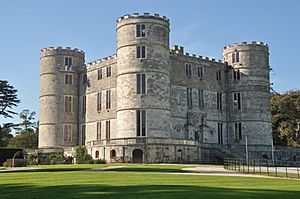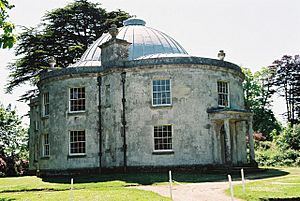Thomas Weld (of Lulworth) facts for kids
Quick facts for kids
Thomas Bartholomew Weld
|
|
|---|---|
| Born | 24 August 1750 |
| Died | 1810 (aged 59–60) Stonyhurst College, Lancashire
|
| Burial place | Lulworth Castle Chapel, Purbeck District, Dorset |
| Nationality | British |
| Occupation | Landowner, philanthropist and book collector |
| Known for | Rare books collection, Philanthropy: Stonyhurst College, Stonyhurst Saint Mary's Hall |
| Family | Thomas Weld, Edward WeldJr., Maria Fitzherbert, Weld-Blundell family |
Thomas Bartholomew Weld (1750–1810) was an important member of the English Catholic gentry. He was also known as Thomas Weld of Lulworth Castle. He owned a lot of land, helped many people, and loved collecting books. Thomas Weld was connected to many leading Catholic families in England. He was a great supporter of the Society of Jesus (Jesuits) in England. He gave his Stonyhurst estate to them in 1794, which helped their schools and religious work. He also helped other Catholic religious groups and priests. Thomas Weld was a personal friend of King George III. His sister-in-law was Maria Fitzherbert. After the French Revolution, he welcomed members of the French royal family who had to leave their country to stay at his castle. In 1786, he built the first Roman Catholic church in England after the Protestant Reformation.
Contents
Thomas Weld's Early Life
Thomas Weld was born into an old Catholic family that had kept their faith even when it was difficult. This type of family was called "recusant." His family was descended from Sir Humphrey Weld, who became the Lord Mayor of London in 1608. Thomas was the fourth son of Edward Weld and Mary Teresa Vaughan. Sadly, two of his older brothers and both his parents died when he was young. When he was six years old in 1761, Thomas inherited the Bowland-with-Leagram and Stonyhurst estates in Lancashire. He received these from his father's cousin, Maria Shireburn.
Thomas was taught at home for a while. Later, he went to a Jesuit school in Europe, first at Watten and then at Bruges. His schooling was often interrupted by political problems in the area. Even though he wasn't known as a top student, he grew to love the school community. This experience made him very interested in education for the rest of his life.
After returning to England, Thomas married Mary Stanley-Massey-Stanley. She was the daughter of Sir John Stanley-Massey-Stanley. Thomas and Mary had a large family with six daughters and nine sons. Their oldest son, also named Thomas, later became a priest and even a Cardinal after his wife passed away.
Thomas's older brother, Edward, died in a horse-riding accident in 1775. This meant that Thomas inherited the family's wealth and properties. Edward's widow, Maria Smythe, later married Thomas Fitzherbert, who also died young. Maria then met the Prince of Wales, who would become King George IV. They had a private marriage in 1785. However, the King and the government did not accept this marriage.
A Love for Books and Art
As the new owner of Lulworth Castle and the Lulworth Estate, Thomas Weld moved there with his wife. He updated the inside of the "castle" in a popular style called "Adam style." The most impressive room was said to be the library. This shows that Thomas loved books very much. He was a "bibliophile," which means a person who collects and loves books.
His collection included some very rare and important books. For example, he owned the Luttrell Psalter, which is a famous medieval book. He also had a 1587 edition of Holinshed's Chronicles, which was a history book used by Shakespeare. All of Thomas Weld's books had a special label inside called an "ex libris." These labels had the family motto, "nil sine numine." This means "Nothing without divine providence." Thomas Weld also collected artworks. He was friends with Giles Hussey, an artist who specialized in portraits. Two pencil drawings of Thomas and his wife Mary still exist today.
Lulworth Castle was originally built as a hunting lodge. Sadly, a big fire damaged it in 1929. However, some valuable items inside the castle were saved before the fire. One of these was a book called History of Japan by Engelbert Kaempfer.
Building a New Church

For a long time, Catholics in England were not allowed to worship in public churches. So, the Weld family had religious services in a private chapel inside Lulworth Castle. One of their chaplains was a French Jesuit priest named Jean Grou. He had to flee France because of the French Revolution. He stayed at Lulworth for almost ten years, writing many spiritual books.
Because Thomas Weld was a personal friend of King George III, he received special permission. In 1786, he was able to build a Roman Catholic church dedicated to St. Mary on the grounds of Lulworth Castle. This church would serve as the family's chapel. The King agreed, but only if the building did not look like a church from the outside. Thomas asked John Tasker, who had worked on the castle's interior, to design it. The design was inspired by an ancient Greek mausoleum (a grand tomb). It cost £2,380 to build. This was the first Catholic chapel built in England since the Protestant Reformation. Thomas and his wife were later buried there. Today, the building is a Grade I listed building, meaning it is very important historically.
Important religious events happened at this chapel. On August 15, 1790, John Carroll, an American Jesuit and friend of Thomas, became a bishop there. He was consecrated by Bishop Charles Walmesley and another friend, Charles Plowden. John Carroll later became the first Roman Catholic archbishop of Baltimore in the United States. Another bishop, John Douglass, was also consecrated in the chapel on December 19 of the same year.
Helping Others
Thomas Weld became especially known for his charity work. He helped English people who had to leave their homes because of the French Revolutionary wars. He gave his estate, Stonyhurst, near Clitheroe, to the English Jesuits who were returning from exile. He also supported the English Poor Clares, a group of nuns who had fled from France. He even started and supported a Trappist monastery at Lulworth. This monastery later moved to Ireland and is now called Mount Melleray Abbey.
After the French Revolution, some members of the French royal family were invited to stay at Lulworth Castle. Later, Charles X of France and his family also stayed there briefly in 1830. They were guests of Joseph Weld, Thomas's son, while on their way to Scotland.
Thomas Weld was known for being very religious and welcoming. He gave money to build a church, St Michael's and St John's in Clitheroe. He asked the priest there to say a special Mass each year for him and his wife. He was also one of the first English Catholics to invite the King to visit his home. King George III visited the Lulworth Estate in 1789 and 1791. Thomas Weld died suddenly at Stonyhurst. He was buried in the chapel at Lulworth Castle. It is believed that Thomas Weld gave away half of his income to help others.
The Weld Family Motto
The Weld family motto is Nil sine numine. This Latin phrase means "Nothing without divine providence." It is a motto shared by the State of Colorado in the United States and several American institutions.
Thomas Weld's Children
Thomas Weld and his wife, Mary Massey-Stanley, had fifteen children:
- Thomas (born 1773): He married Lucy Clifford in 1796 and had a child. After his wife died, he became a priest and then a cardinal.
- Juliana (born 1774): She never married.
- Edward (born 1775): He died young.
- Joseph (born 1777): He married Charlotte Mary Stourton in 1802 and had children.
- Catherine Winifred (born 1776): She married William Stourton, 18th Baron Stourton and had children.
- John (born 1780): He became a Jesuit priest and was the head of Stonyhurst College.
- William (born 1781): He died young.
- Humphrey (born 1783): He married Christiana-Maria Clifford and had children.
- Mary Theresa (born 1784): She became a nun.
- James (born 1785): He married Juliana-Anne Petre and had children.
- George (born 1786): He married Maria Searle and had children.
- Francis (born 1787): He died young.
- Clare (born 1788?): She became a nun.
- Elizabeth Mary (born 1789?): She married Charles Thomas Bodenham de la Barre and had children.
- Theresa (born 1792?): She married William Vaughan.
Notable Descendants
- Joseph Weld was the third son of Thomas Weld. He took over the Lulworth Castle and estates after his brother Thomas. Joseph is remembered for building and sailing fast yachts. His most famous boat was The Arrow, which raced in the first America's Cup in 1851. Joseph also founded the Royal Yacht Squadron on the Isle of Wight.
- Thomas Weld (1808-1887) inherited Lulworth. He later took the name Blundell to inherit another estate.
- Humphrey Weld of Chideock (1783–1852) was the sixth son of Thomas Weld. He lived at Chideock Manor in Dorset.
- Charles Weld, Humphrey's oldest son, was a talented artist. He copied many pictures of English martyrs, which are now missing.
- Sir Frederick Weld (1823–1891), another son of Humphrey Weld, became the Prime Minister of New Zealand. He was also the Governor of Western Australia.
- James Weld of Cowsfield (1785–1855) was the seventh son of Thomas Weld.
- Mgr Francis Weld (died 1898), James Weld's son, wrote a book called Divine Love, and the Love of God's Most Blessed Mother.
- George Weld of Leagram Park (1786–1866) was the eighth son of Thomas Weld.
- Alfred Weld (1823–1890), George Weld's son, was a leading English Jesuit. He wrote a book about the Jesuit order.
See also
- William Clifford
- Edward Stourton
- Cardinal Herbert Vaughan




